Katie is our exceptional Lead Designer who possesses an innate passion for designing websites and creating captivating themes and aesthetics. Her unparalleled dedication to producing innovative solutions that address client needs and reshape user perceptions is truly commendable. Katie finds immense gratification in crafting tangible designs that leave a lasting impact. Equipped with a comprehensive university degree in Computer Management and Web-Based Studies, Katie brings a wealth of knowledge to the forefront of her role at Loop. Her educational background empowers her to leverage cutting-edge technologies and industry best practices to deliver exceptional design solutions. Katie's expertise shines through her ability to revamp websites, logos, and brands, allowing clients to showcase their business in a fresh and illuminating manner. Her keen eye for detail and creative flair breathe new life into digital assets, providing a platform for clients to shine in their respective industries. In addition to her professional pursuits, Katie's passion for baking serves as a testament to her creative nature and attention to detail. This dedication extends beyond her design work and fuels her ability to approach each project with meticulousness and care. Her ability to understand clients' unique requirements and translate them into captivating designs has garnered her praise and established her as a trusted design partner. Katie's professionalism and unwavering enthusiasm make her an invaluable asset to our team. Her expertise in website design, coupled with her dedication to delivering tangible results, sets her apart as a Lead Designer. Clients can expect nothing short of exceptional designs that elevate their brand, captivate their audience, and drive success.
Posted on 12/11/2024 by Katie Manning
The essential guide to Conversion Rate Optimisation (CRO)
Conversion Rate Optimisation (CRO) is a crucial aspect of digital marketing that focusses on increasing the percentage of visitors who complete a desired action on a website. This guide will provide a comprehensive structure to understand and implement effective CRO strategies.
What is Conversion Rate Optimisation?
Conversion Rate Optimisation (CRO) is a process that aims to increase the percentage of website visitors who take a desired action, such as making a purchase, filling out a form, or subscribing to a newsletter. This is achieved by optimising website elements and user experiences to make it easier and more appealing for visitors to complete their intended goals.
To make it simpler, imagine your website is a store. You want as many people as possible to come in, but you also want them to buy something. Conversion Rate Optimisation (CRO) is like rearranging the store’s layout, making sure the products are easy to find, and creating a friendly atmosphere so people feel comfortable buying. The goal is to get more people to leave the store with something in their hands.
Elements of CRO
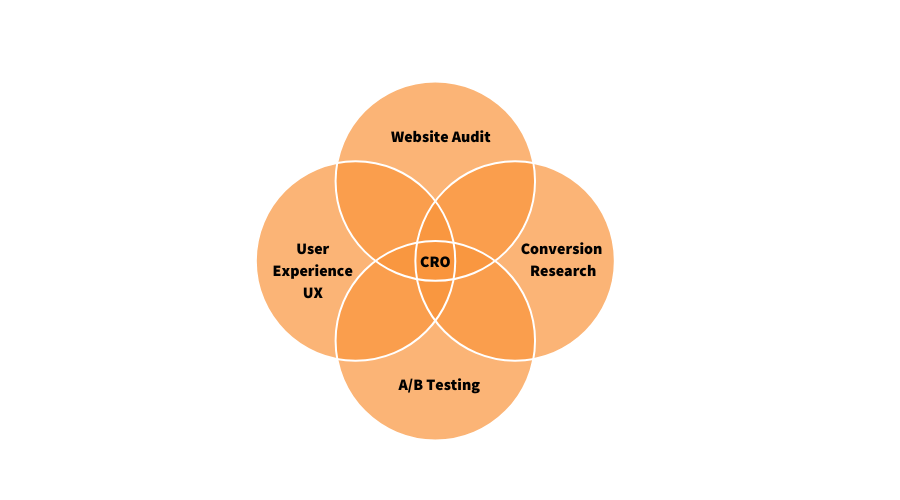
What is CRO in digital marketing?
CRO plays a vital role in digital marketing for several reasons:
- Increased Revenue: By converting more visitors into customers, CRO directly contributes to increased revenue.
- Improved ROI: CRO can help businesses get more value out of their marketing efforts by optimising the effectiveness of their websites.
- Enhanced User Experience: CRO focusses on creating a better user experience, leading to increased satisfaction and loyalty.
- Data-Driven Decision Making: CRO relies on data to make informed decisions, ensuring that optimisations are effective and targeted.
Understanding Conversion Rates
Conversion rates are a fundamental metric in digital marketing, representing the percentage of visitors who complete a desired action on a website or in a marketing campaign. These actions can range from making a purchase to signing up for a newsletter. Understanding conversion rates is crucial, as they directly reflect the effectiveness of your marketing efforts and the overall user experience. By tracking and analysing conversion rates, businesses can gain insights into user behaviour, identify areas for improvement, and make data-driven decisions to optimise their digital presence.
Key Metrics to Measure Conversion Rates
Core Conversion Metrics
- Conversion Rate: The percentage of visitors who complete a desired action (e.g., purchase, signup).
- Conversion Rate by Device: Track conversion rates for different devices (desktop, mobile, tablet) to identify potential device-specific issues.
- Conversion Rate by Traffic Source: Analyse conversion rates from various traffic sources (e.g., search engines, social media, email) to determine which channels are most effective.
- Conversion Rate by Landing Page: Evaluate the performance of different landing pages to identify those that are most effective at converting visitors.
Additional Metrics
- Click-Through Rate (CTR): The percentage of users who click on a link or call-to-action (CTA).
- Bounce Rate: The percentage of visitors who leave your site after viewing only one page.
- Time on Site: The average amount of time visitors spend on your site.
- Pages per Session: The average number of pages viewed per visit.
- Cart Abandonment Rate: The percentage of users who add items to their cart but don’t complete the purchase.
Advanced Metrics
- A/B Test Results: Measure the performance of different website variations to identify which elements are most effective at improving conversions.
- Customer Lifetime Value (CLTV): Calculate the total revenue generated by a customer over their lifetime to assess the long-term value of conversions. CLTV = Average Order Value * Purchase Frequency * Customer Lifetime
- Net Promoter Score (NPS): Measure customer satisfaction and loyalty to identify areas for improvement. NPS = % Promoters – % Detractors
Differentiating between micro and macro-conversions
| Macro conversions | Micro conversions |
| Primary goals that directly contribute to business objectives. Examples: completing a purchase; submitting a lead form; requesting a quote. Typically have a direct impact on revenue or the sales pipeline. | Smaller actions that indicate engagement or progression towards macro conversions. Examples: newsletter signups, creating an account, adding items to a wish list. Help in understanding the user journey and identifying potential bottlenecks. |
CRO Process
The CRO process is a systematic approach to improving website performance and increasing conversion rates. It involves a series of steps that help businesses understand user behaviour, identify areas for improvement, and implement data-driven changes. By following this process, companies can continually refine their digital presence to better meet user needs and achieve business objectives.
Step-by-step guide to the CRO process:
- Identifying important conversions: Define primary (macro) and secondary (micro) conversion goals. Align conversion goals with the overall business objectives. Prioritise conversions based on their impact on the business.
- Analysing the conversion funnel: Map out the user journey from initial interaction to final conversion. Identify drop-off points and potential bottlenecks in the funnel. Calculate conversion rates at each stage of the funnel.
- Gathering user data and insights: Implement analytics tools to track user behaviour. Conduct user surveys and interviews. Use heatmaps and session recordings to visualise user interactions. Analyse customer feedback and support tickets.
- Creating hypotheses based on data: Identify patterns and trends in the collected data. Formulate hypotheses about why users are not converting. Prioritise hypotheses based on their potential impact and ease of implementation.
- Testing hypotheses through A/B testing: Design A/B tests to validate hypotheses. Create variations of web pages or elements to test. Implement A/B testing tools and set up experiments. Ensure statistical significance in the test results.
- Reviewing results and iterating improvements: Analyse test results to determine winning variations. Implement successful changes site-wide. Document the learnings from both successful and unsuccessful tests. Use insights to inform future hypotheses and tests. Continuously repeat the process to achieve ongoing improvements.
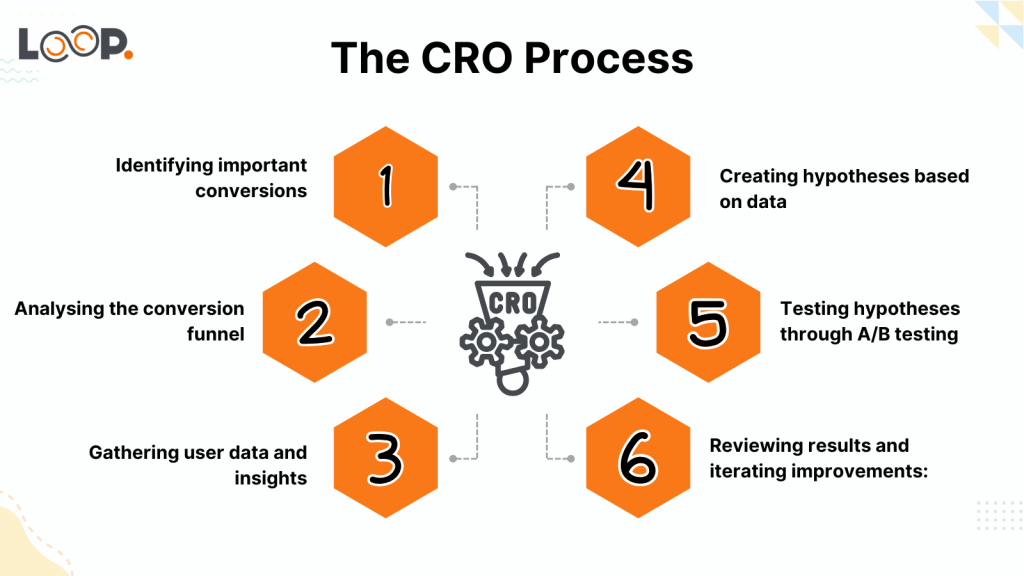
Conducting a CRO audit
A Conversion Rate Optimisation (CRO) audit is a critical step in improving a website’s performance and increasing conversions. It involves a comprehensive analysis of a website’s current state, user behaviour, and conversion funnel to identify areas for improvement.
The importance of a CRO audit lies in its ability to provide data-driven insights that guide optimisation efforts. By conducting a thorough audit, businesses can uncover hidden issues, understand user pain points, and prioritise changes that will have the most significant impact on conversion rates. This process helps companies make informed decisions about where to focus their optimisation efforts, ultimately leading to more effective use of resources and improved ROI.
Steps to Perform a Comprehensive CRO Audit:
Evaluating Website Usability and User Experience
- User Testing: Observe users as they navigate your website to identify pain points, frustrations, and areas of confusion.
- Heuristic Evaluation: Assess your website against established usability principles (Jakob Nielsen’s Heuristics) to identify potential issues.
- Card Sorting: Ask users to categorise content to understand how they perceive your information structure.
- Tree Testing: Validate your site’s information architecture by asking users to find specific information.
Identifying Barriers to Conversion
- Analytics Analysis: Use tools like Google Analytics to identify pages with high bounce rates, low conversion rates, or significant drop-off points.
- Form Analysis: Analyse form fields to identify potential barriers, such as excessive length, required fields, or unclear labels.
- Checkout Process Review: Evaluate the checkout process to identify any friction points that might discourage purchases.
- Customer Feedback: Collect feedback from customers through surveys, reviews, or support interactions to understand their experiences.
Using Tools Like Heatmaps and Analytics for Insights
- Heatmaps: Visualise where users are clicking, scrolling, and engaging with your website to identify areas of interest and disinterest.
- Click Tracking: Track which elements of your website are being clicked on to understand user behaviour.
- Scroll Depth Analysis: Measure how far down the page users are scrolling to identify content that is being missed.
- A/B Testing: Experiment with different website variations to test hypotheses and identify the most effective elements.
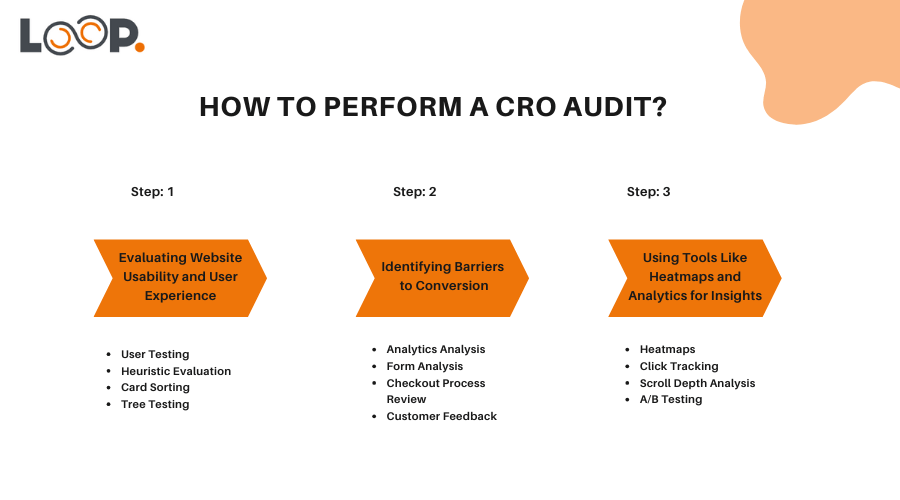
Customer Research for CRO
Customer research is a crucial component of Conversion Rate Optimisation (CRO), providing invaluable insights into user behaviour, preferences, and pain points. By combining qualitative and quantitative research methods, businesses can gain a comprehensive understanding of their audience and make data-driven decisions to improve conversion rates.
The importance of qualitative and quantitative research
| Aspect | Qualitative Research | Quantitative Research |
| Insights | Provides in-depth insights into user motivations and emotions. | Provides measurable data to track performance and trends. |
| Benefits | Helps uncover unexpected issues or opportunities. | Allows for statistical analysis and comparison. |
| Context | Offers context to quantitative data | It helps identify patterns across large user groups. |
| Examples | Interviews, open-ended survey questions, usability testing observations | Website analytics, closed-ended survey questions, A/B test results |
Techniques for gathering user feedback:
- Surveys and interviews: Online surveys:
- Use tools like SurveyMonkey or Google Forms.
- Ask a mix of closed and open-ended questions..
- Target specific user segments or display exit-intent surveys.
- Customer interviews:
- Conduct one-on-one interviews with customers or potential customers.
- Use open-ended questions to encourage detailed responses.
- Focus on understanding their decision-making process and pain points
- Usability testing: moderate usability tests:
- Observe users as they complete specific tasks on your website.
- Encourage participants to think aloud as they navigate.
- Take notes on their actions, comments, and areas of confusion.
- Remote usability testing:
- Use tools like UserTesting or TryMyUI for unmoderated tests.
- Provide participants with specific scenarios and tasks.
- Analyse recorded sessions and written feedback.
- Analysing user behaviour through analytics tools: Web analytics:
- Use Google Analytics or similar tools to track user behaviour.
- Analyse metrics such as bounce rate, time on page, and conversion rates..
- Set up goal tracking to measure specific user actions..
- Heatmaps and session recordings:
- Implement tools like Hotjar or Crazy Egg.
- Visualise user clicks, scrolling behaviour, and mouse movements.
- Review individual user sessions to identify common patterns or issues.
- Form analytics:
- Use tools like Formisimo or Hotjar Forms.
- Analyse form completion rates and identify problematic fields.
- Track the time spent on each form field.
- User flow analysis:
- Utilise tools like Google Analytics’ User Flow report.
- Identify common paths users take through your site.
- Pinpoint, where users commonly exit or drop off
Designing for Conversions: Principles and Best Practices
Effective web design is crucial for driving conversions. By adhering to sound design principles and prioritising the user experience (UX), you need customised websites that are not only visually appealing but also highly effective at turning visitors into customers. Let’s explore how to achieve this with real-world examples and analogies to illustrate these points.
Principles of Effective Web Design for CRO
1. Simplicity: Keeping the design simple and uncluttered allows users to focus on the most important elements of your website. For instance, the UK-based company Innocent Drinks uses a minimalist design on their website. The homepage features large, attractive product images against a simple, white background with minimal text and navigation options. This simplicity draws attention to their product offerings and brand ethos, making it easy for users to understand what the company is about.

Image Source: Innocent Drinks
2. Clarity: A clear and easily understandable message is key to guiding users through your site. The Guardian newspaper’s online subscription page is a good example of clarity. The page clearly states the benefits of subscribing, such as ad-free reading and supporting independent journalism. It uses straightforward language and bullet points to convey key information quickly.
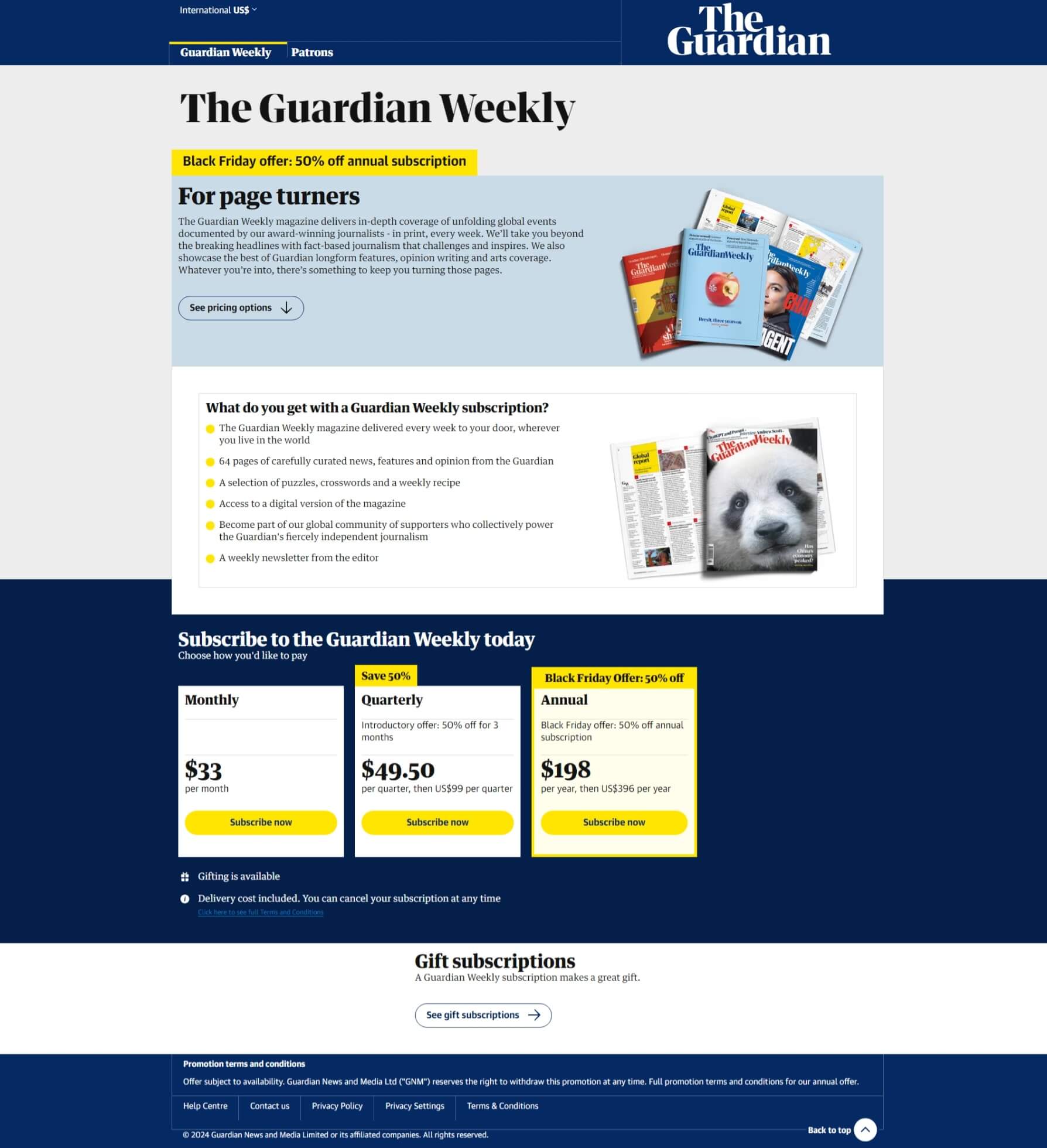
Image Source: The Guardian
3. Consistency: Consistency across your website’s design elements helps to build trust and makes navigation intuitive. For instance, the fashion retailer ASOS maintains a consistent look across its website. Their colour scheme, typography, and layout remain uniform, creating a cohesive and professional appearance. Whether you’re on the homepage or a product page, the design elements are the same, which makes the user feel more comfortable and familiar with the site.

Image Source: ASOS
4. Speed: Optimising your website for fast loading times is crucial, as slow websites can deter visitors. The BBC website, for example, is optimised for speed despite having rich multimedia content. They use techniques like content delivery networks (CDNs) and image optimisation to ensure fast loading times, even during high-traffic events like breaking news.
5. Mobile-Friendliness: Designing your website to be responsive and accessible on all devices is essential in today’s mobile-centric world. The UK government’s website, GOV.UK is an excellent example of mobile-friendliness. It uses a responsive design that adapts to different screen sizes, ensuring that users have a seamless experience whether they’re on a desktop, tablet, or smartphone.
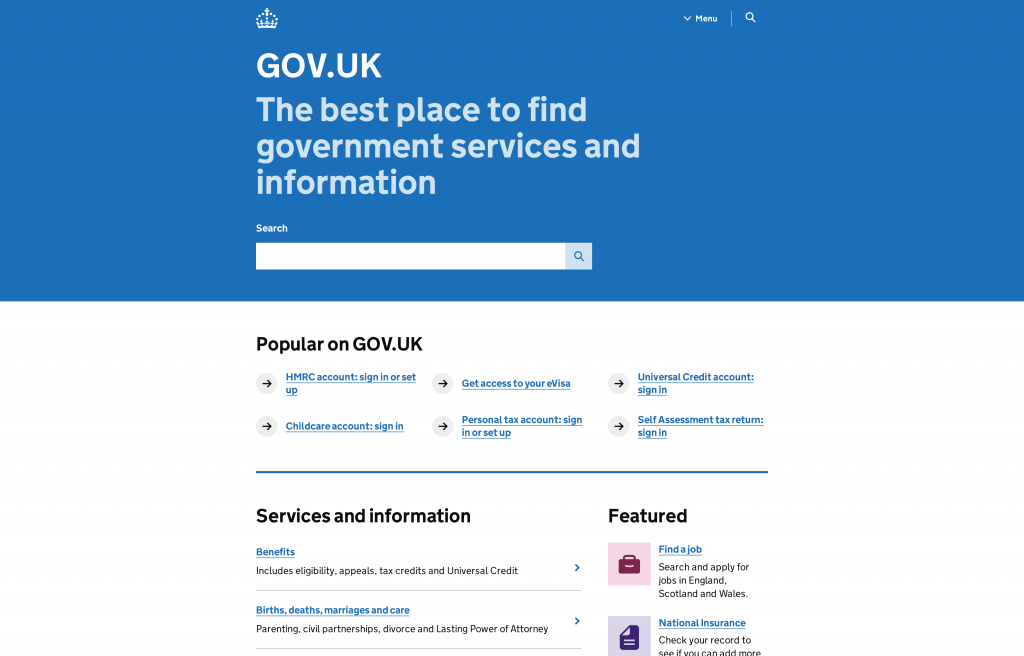
Image Source: GOV.UK site
Importance of User Experience (UX) in Conversion Rates
A positive user experience is essential for driving conversions. When visitors have a seamless and enjoyable experience on your website, they are more likely to take the desired action, such as making a purchase or signing up for a newsletter. On the other hand, poor UX can lead to frustration and abandonment.
For example, online grocery retailer Ocado focuses heavily on the user experience. They provide a smooth shopping experience with features like easy navigation, quick reordering options, and personalised recommendations based on past purchases. This attention to UX helps Ocado retain customers and encourages them to continue shopping.
Best Practices for Optimising Landing Pages
- Clear and Compelling Headlines: Your headline should be attention-grabbing and clearly communicate the value proposition of your offer.
- Effective Use of Images and Visuals: High-quality images and visuals can help to break up text, enhance the visual appeal of your landing page, and reinforce your message.
- Strategic Placement of Calls-to-Action (CTAs): Your CTA should be prominently displayed and easy to find. Consider using contrasting colours and a clear, action-orientated phrase (e.g., “Buy Now,” “Sign Up”).
A/B Testing and Experimentation
A/B testing is a powerful method for testing different versions of a web page or element to determine which performs better. It involves creating two or more variations of a page or element (A and B) and randomly assigning visitors to each version. By analysing the results, you can identify which version leads to higher conversion rates.
Significance of A/B Testing in CRO
A/B testing is essential for CRO because it provides a data-driven approach to improving website performance. By testing different variations, you can:
- Identify the most effective elements: Determine which designs, headlines, CTAs, or other elements lead to higher conversion rates.
- Optimise the user experience: improve the user journey and make it easier for visitors to achieve their goals.
- Reduce guesswork: Make informed decisions based on data rather than relying on assumptions.
- Continuously improve: Use A/B testing as an ongoing process to continuously refine your website and increase conversions.
Best Practices for Conducting A/B Tests
- Choose the right variables to test:
- Hypothesis-Driven Testing: Formulate clear hypotheses about how changes will impact conversions.
- Prioritise High-Impact Elements: Focus on testing elements that are likely to have a significant impact on conversions.
- Avoid Testing Too Many Variables: Limit the number of variables you test at once to avoid confounding results.
- Setting up tests and measuring outcomes:
- Random Assignment: Ensure that visitors are randomly assigned to each variation to avoid bias.
- Sufficient Sample Size: Collect enough data to ensure statistically significant results.
- Clear Metrics: Define the key metrics you will use to measure the success of your test (e.g., conversion rate, click-through rate, time on site).
- Interpreting Results and Making Data-Driven Decisions:
- Statistical Significance: Evaluate the statistical significance of the results to determine if they are truly meaningful.
- Consider Other Factors: Consider factors such as seasonality, promotions, or external events that may have influenced the results.
- Implement Winning Variations: Roll out the winning variation and continue to monitor its performance.
Essential Tools for CRO
Effective CRO requires a robust toolkit to analyse user behaviour, conduct experiments, and track conversion metrics. Here are some of the most essential tools:
User Behaviour Analysis Tools
These tools help you visualise how users interact with your website, identify pain points, and understand their behaviour.
HotJar
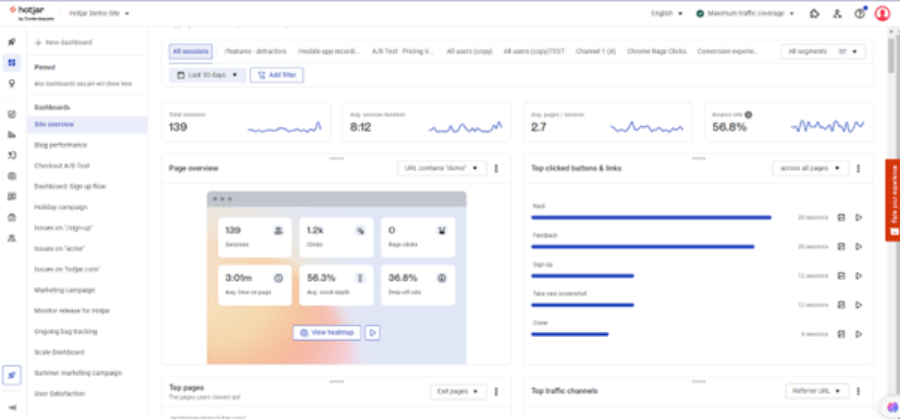
Key features of Hotjar
- Heatmaps
- Session recordings
- Surveys
- Insights into user behaviour
Crazy Egg
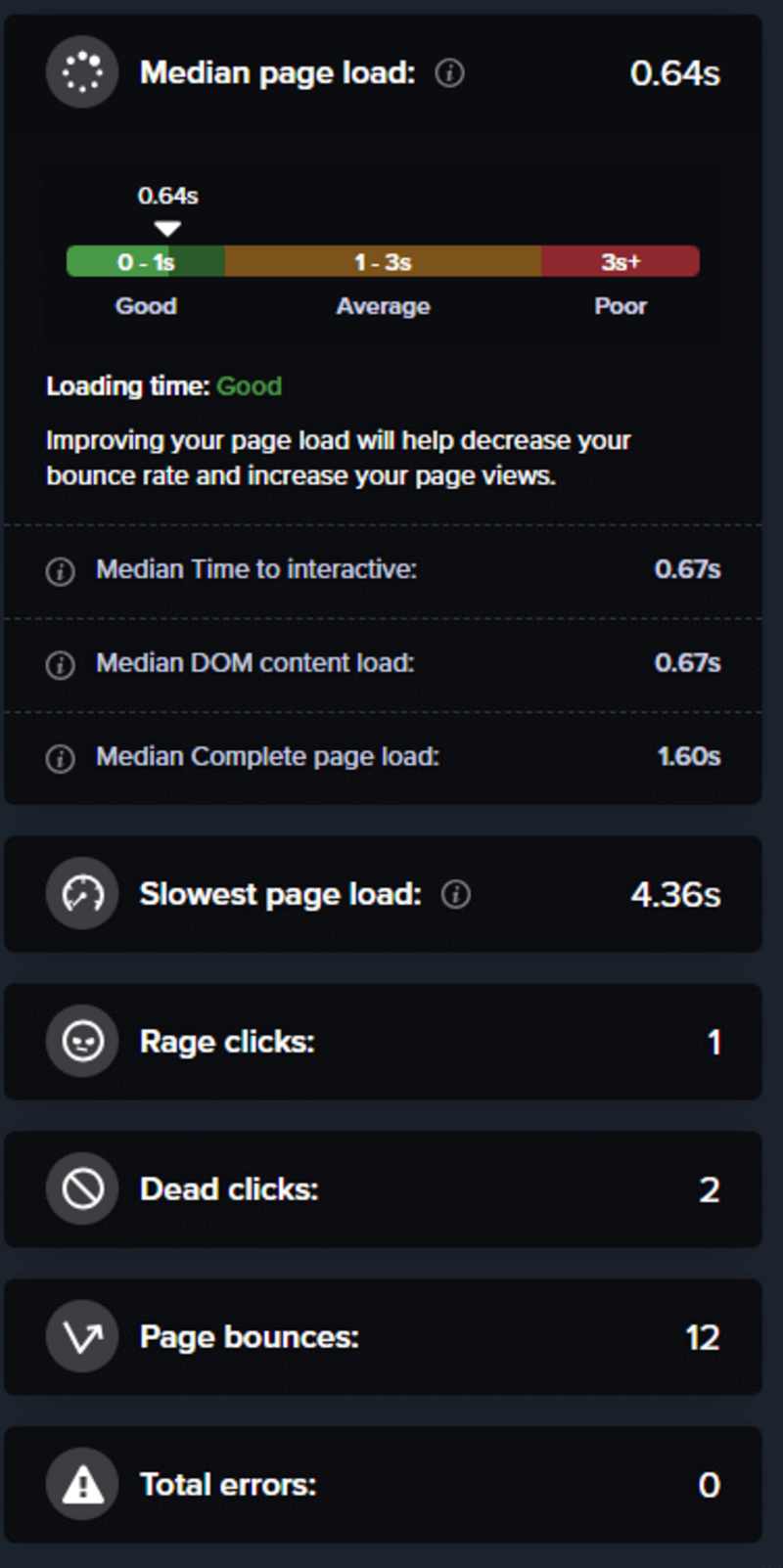
Key Features of Crazy Egg
- Heatmaps
- Click tracking
- Scroll maps
- Visualises user interactions
User Testing
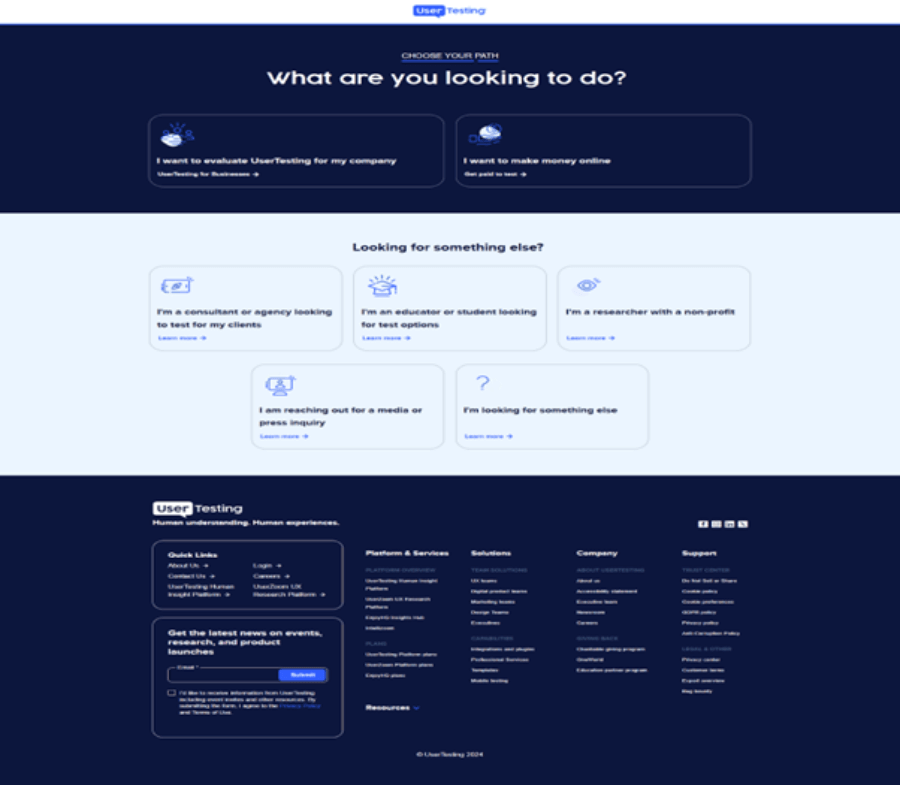
Key Features of User Testing
- Conducts user research.
- Gathers feedback
- Focus on website usability testing.
Full Story
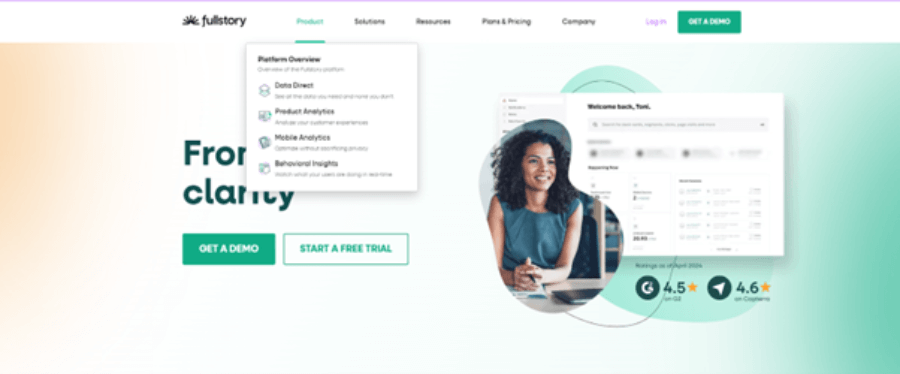
Key Features of Full Story
- Records user sessions
- Understands the entire user journey.
- Identifies issues
A/B Testing Platforms
A/B testing platforms allow you to create and manage experiments, test different variations of your website, and analyse the results.
| Platforms | Features |
| Optimizely | A popular A/B testing platform with advanced features for personalisation and multivariate testing. |
| VWO | Offers A/B testing, multivariate testing, and personalisation capabilities. |
| Convert.com | Provides A/B testing, split URL testing, and heatmaps. |
| AB Tasty | Offers A/B testing, personalisation, and feature flagging. |
Analytics tools are essential for tracking website performance, measuring conversions, and identifying trends.
| Analytic Tools | Features |
| Google analytics | A free and powerful tool for tracking website traffic, user behaviour, and conversions. |
| Adobe analytics | A comprehensive analytics platform with advanced features for data analysis and reporting. |
| Mixpanel | A product analytics tool that focusses on tracking user behaviour and understanding customer journeys. |
| Matomo (formerly Piwik) | A self-hosted analytics platform that provides privacy-focused tracking and analysis. |
Additional Tools
- Content Management Systems (CMS): Platforms like WordPress, Drupal, and Joomla often have built-in A/B testing or integration with CRO tools.
- Customer Relationship Management (CRM) Systems: Tools like Salesforce and HubSpot can help you track customer interactions and measure the impact of CRO efforts.
- Survey Tools: Platforms like SurveyMonkey and Typeform can be used to gather feedback from users and identify areas for improvement.
Strategies for e-commerce CRO
E-commerce businesses can significantly improve their conversion rates by implementing targeted CRO strategies.
Specific Tactics for Optimising E-Commerce Sites
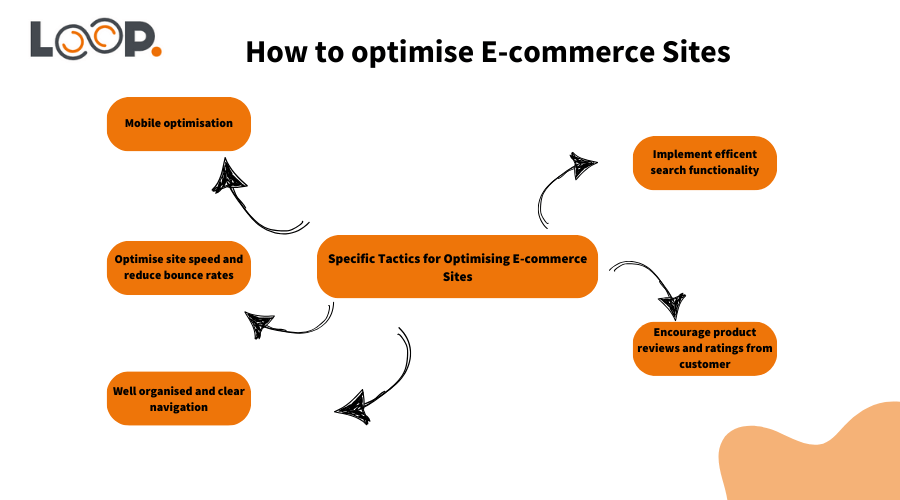
Enhancing Product Pages and Checkout Processes
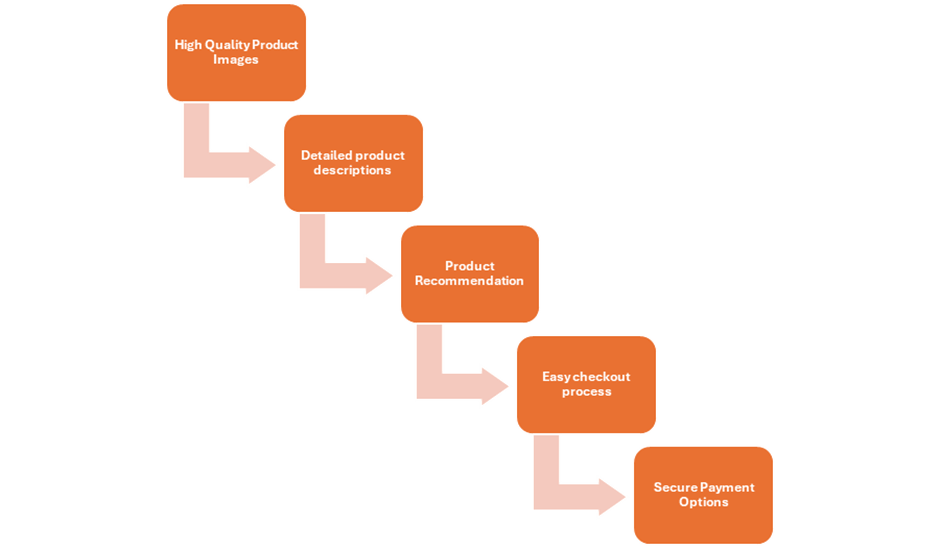
Personalisation Strategies to Boost Conversion Rates
- Personalised Product Recommendations: Use customer data and purchase history to recommend products tailored to individual preferences.
- Personalised Email Marketing: Send targeted email campaigns based on customer behaviour and interests.
- Dynamic Content: Display personalised content on your website, such as product recommendations or tailored offers.
- Behavioural Retargeting: Use retargeting ads to re-engage website visitors who abandoned their carts or viewed specific products.
Advanced CRO Techniques
As Conversion Rate Optimisation (CRO) continues to evolve, advanced techniques are emerging to optimise website performance and drive conversions. One of the most promising strategies is leveraging AI and machine learning for CRO. These technologies enable predictive analytics, which can be used to anticipate user behaviour and personalise the website experience accordingly. Additionally, automated A/B testing employs machine learning algorithms to design and execute tests automatically, identifying optimal variations more efficiently. Another advanced approach is delivering dynamic content, which tailors the user experience based on individual preferences, behaviour, and context. Chatbots and virtual assistants also play a significant role, offering instant customer support and assistance, thus enhancing user satisfaction and conversion rates.
Multi-variate Testing as an Advanced Strategy
Multi-variate testing is a more complex form of A/B testing that allows you to simultaneously test multiple variables on a single page. This can provide deeper insights into how different elements interact and identify the optimal combination for conversions.
- Simultaneous Testing: Test multiple variations of different elements (e.g., headlines, images, CTAs) at the same time.
- Increased Complexity: Handle more complex scenarios and identify more nuanced interactions between elements.
- Data-Driven Optimisation: Make more informed decisions based on the extensive data generated by multi-variate testing.
The Role of Psychological Triggers in Enhancing Conversions
Understanding human psychology is crucial for effective CRO. By leveraging psychological triggers, you can influence user behaviour and increase conversions.
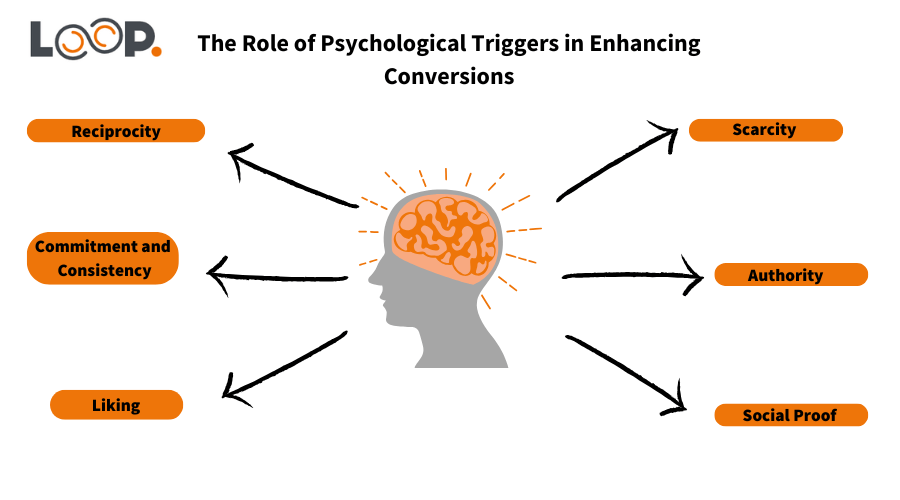
Scarcity: According to a study, when a product’s availability is limited, consumers perceive it as more valuable and desirable. This sense of urgency can lead to increased conversion rates. For example, e-commerce sites that use scarcity-related language (like “Only 2 left in stock!”) see conversion rates increase by as much as 226%.
Authority: A survey by Nielsen found that 70% of consumers trust product recommendations from people they consider experts. This highlights the importance of using endorsements and authoritative figures to build credibility and trust, which can lead to higher conversion rates.
Social Proof: Research by BrightLocal reveals that 88% of consumers trust online reviews as much as personal recommendations. Additionally, the presence of user-generated content, such as customer reviews and testimonials, can boost conversion rates by up to 161%.
Reciprocity: The principle of reciprocity is powerful in driving conversions. For instance, offering a free trial or a free sample can increase conversions. A study by Wisernotify showed that companies using free trials experience an average conversion rate of 30%.
Commitment and Consistency: A study published in the Journal of Marketing Research demonstrated that people are more likely to follow through with larger commitments if they have made a smaller, initial commitment. For example, asking users to sign up for a newsletter can make them more likely to make a purchase later, increasing conversion rates.
Liking: The principle of liking, which involves creating a positive and engaging user experience, is also effective. Research has shown that users are more likely to convert if they have a positive interaction with a brand.
Measuring Success and Continuous Improvement
To effectively track the progress of your CRO efforts and ensure ongoing success, it’s essential to establish key performance indicators (KPIs) and set up dashboards for continuous analysis.
Key Performance Indicators (KPIs) for CRO
| KPI | Function | Formula |
| Conversion Rate | The percentage of visitors who take a desired action (e.g., purchase, sign up, download). | Conversion Rate = (Number of Conversions) / (Total Visitors) * 100 |
| Conversion Rate by Device | Track conversion rates for different devices to identify potential device-specific issues. | Conversion Rate for Device X = (Number of Conversions on Device X) / (Total Visitors on Device X) * 100 |
| Conversion Rate by Traffic Source | Analyse conversion rates from various traffic sources (e.g., search engines, social media, email) to determine which channels are most effective. | Conversion Rate for Traffic Source X = (Number of Conversions from Traffic Source X) / (Total Visitors from Traffic Source X) * 100 |
| Conversion Rate by Landing Page | Evaluate the performance of different landing pages to identify those that are most effective at converting visitors. | Conversion Rate = (Number of Conversions on Landing Page) / (Total Visitors to Landing Page) * 100 |
| Click-Through Rate (CTR) | The percentage of users who click on a link or call-to-action (CTA). | CTR = (Number of Clicks) / (Number of Impressions) * 100 |
| Bounce Rate | The percentage of visitors who leave your site after viewing only one page. | Bounce Rate = (Number of Single-Page Sessions) / (Total Sessions) * 100 |
| Time on Site | The average amount of time visitors spend on your site. | Average Time on Site = (Total Time Spent on Site) / (Total Sessions) |
| Pages per session | The average number of pages viewed per visit. | Pages per session = (total pageviews) / (total sessions) |
| Cart Abandonment Rate | The percentage of users who add items to their cart but don’t complete the purchase. | Cart Abandonment Rate = (Number of Abandoned Carts) / (Total Carts Created) * 100 |
| Customer Lifetime Value (CLTV) | Calculate the total revenue generated by a customer over their lifetime to assess the long-term value of conversions. | CLTV = Average Order Value * Purchase Frequency * Customer Lifetime |
Setting Up Dashboards for Ongoing Analysis

The Importance of Continuous Testing and Optimisation
Continuous testing and optimisation are crucial components of successful Conversion Rate Optimisation (CRO). Unlike a one-time event, CRO is an ongoing process that requires regular attention and adjustment. By consistently analysing your website data, you can identify new opportunities for improvement, whether it’s through enhancing the user experience, updating content, or redesigning elements to boost engagement.
Testing and iterating are vital to this process. Conducting A/B tests and other experiments allows you to compare different variations of your website elements to see what resonates best with your audience. This iterative approach helps you refine your website continuously, ensuring that you are always working towards the most effective version.
Adapting to changes is also important in a fast-paced digital environment. Staying up-to-date with industry trends and shifts in user behaviour means you can proactively adjust your CRO strategies, ensuring they remain relevant and effective.
Lastly, monitoring your website’s performance is essential. By continuously tracking key performance indicators (KPIs), you can quickly spot areas that need improvement and make the necessary adjustments. This constant vigilance helps maintain high conversion rates and gives you a competitive edge in the market.
To wrap up!
Conversion Rate Optimisation (CRO) is a critical aspect of digital marketing that focuses on increasing the percentage of website visitors who complete desired actions. This comprehensive approach encompasses understanding conversion rates, conducting thorough audits, implementing advanced techniques, and continuously measuring success.
At its core, CRO is about enhancing the user experience and making it easier for visitors to achieve their goals on a website. This process begins with analysing user behaviour and identifying areas for improvement. By leveraging both qualitative and quantitative research methods, businesses can gain deep insights into their audience’s needs and preferences.
A systematic approach to CRO involves several key steps. First, businesses must define clear conversion goals and analyse their conversion funnel to identify potential bottlenecks. Next, they gather user data through various methods, such as surveys, interviews, and analytics tools. This information forms the basis for creating hypotheses about why users may not be converting.
These hypotheses are then tested through A/B testing, where different versions of web pages or elements are compared to determine which performs better. The results of these tests inform further improvements, creating a cycle of continuous optimisation.
Advanced CRO techniques include leveraging AI and machine learning for personalisation, implementing psychological triggers to influence user behaviour, and using multivariate testing to analyse complex interactions between different website elements.
For e-commerce businesses, specific strategies can be applied to product pages, checkout processes, and personalised recommendations to boost conversions. Throughout the CRO process, it’s crucial to measure success using key performance indicators (KPIs) and maintain dashboards for ongoing analysis.
As the digital landscape evolves, staying current with emerging technologies and shifting consumer behaviours is essential for maintaining effective CRO strategies. By embracing this continuous process of testing, analysis, and optimisation, businesses can significantly improve their website performance, enhance the user experience, and ultimately drive more conversions in an increasingly competitive online marketplace.
Key Takeaways from the Guide!
- CRO is an ongoing process that involves analysing user behaviour, identifying areas for improvement, and implementing data-driven changes.
- A combination of qualitative and quantitative research methods provides comprehensive insights for an effective CRO.
- User experience (UX) plays a crucial role in conversion rates, emphasising the need for intuitive, user-friendly website designs.
- A/B testing and multivariate testing are essential tools for validating hypotheses and optimising website elements.
- Psychological triggers such as scarcity, social proof, and authority can significantly influence user behaviour and boost conversions.
- Advanced techniques like AI and machine learning are emerging as powerful tools for personalisation and predictive analytics in CRO.
- Continuous measurement and analysis of key performance indicators (KPIs) are vital for tracking progress and identifying new opportunities for optimisation.
- E-commerce businesses can benefit from specific CRO strategies tailored to product pages, checkout processes, and personalised recommendations.
- A robust CRO toolkit, including user behaviour analysis tools, A/B testing platforms, and analytics software, is essential for implementing effective strategies.
- Adapting to changes in consumer behaviour and industry trends is crucial for maintaining successful CRO strategies in the long term.
Loop Digital is your ultimate conversion optimisation machine!
Are you ready to transform your website into a conversion powerhouse? Loop Digital’s expert CRO services can help you unlock your site’s full potential and drive real business growth. Don’t leave your conversion rates to chance – take the first step towards optimising your online presence today. Book a free 30-minute consultation with our CRO specialists to discuss your unique challenges and opportunities. Alternatively, let us conduct a comprehensive, no-obligation site audit to identify quick wins and long-term strategies for boosting your conversions. Whether you’re looking to increase sales, generate more leads, or improve user engagement, our data-driven approach will help you achieve your goals. Contact Loop Digital now and start your journey to higher conversion rates and increased ROI.
Looking for your next opportunity?
Digital marketing careers
We’re always on the lookout for talented individuals to join our ever growing team. If you think you’d be a great match for Loop Digital, we’d love to hear from you.

Join 300+ business owners getting weekly growth strategies - subscribe now.
"*" indicates required fields







